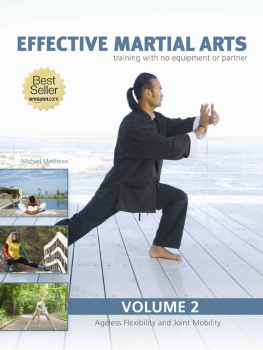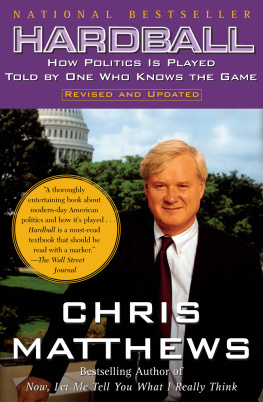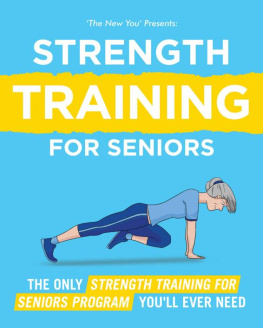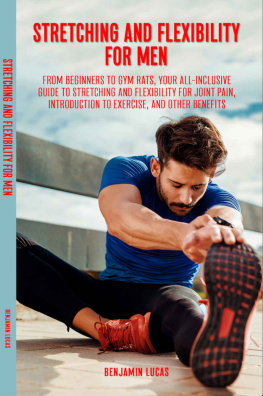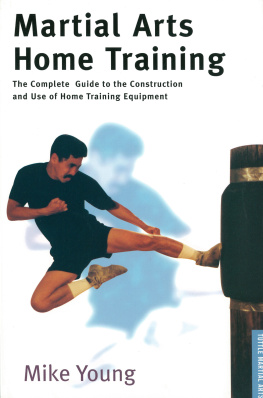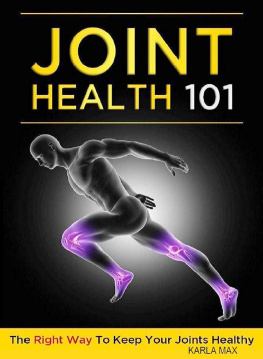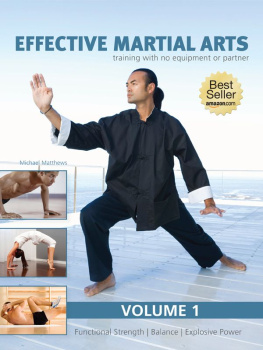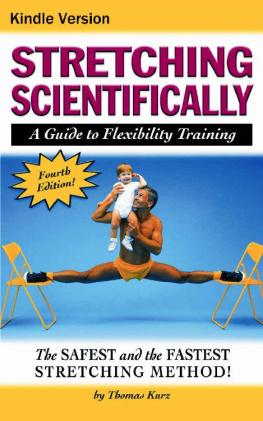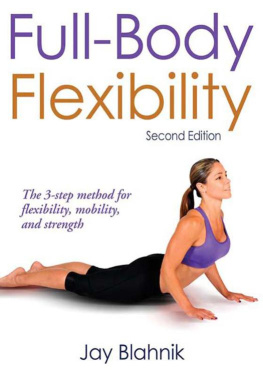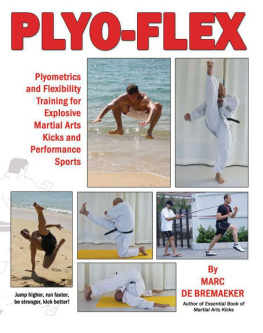Grab the entire
Effective Martial Arts
Training with No Equipment or Partner
collection today!
Functional Strength, Balance and Explosive Power ( B0079ZNPOW ).
Ageless Flexibility and Joint Mobility ( B008FLEDRM ).
Meaningful Combat Psychology and Motivation for Training and Breathing Techniques ( B008FLHZ40 ).
Stamina, Quickness and Endurance in Excess ( B008FLI1KC ).
How to Put It All Together ( B008F9VA8E ).
SAVE BIG: The Master Collection ( B008GD3FNC ): Get All 5 for the Price of 3! Limited Time Offer
COPYRIGHT 2012
All rights reserved
TABLE OF CONTENTS
Contents
Disclaimer:
The material in this book is for informational purposes only. You should use proper discretion, in consultation with a health care practitioner, before undertaking the exercises and techniques described in this book. The author and publisher expressly disclaim responsibility for any adverse effects that may result from the use or application of the information contained in this book.
Introduction:
Flexibility and joint mobility is crucial for martial arts as well as general well-being and health. Some martial arts techniques require a type of flexibility that the average Joe doesnt possess. An obvious example is the high/head kick. If you cant reach the head of your opponent with your shin/foot you will obviously never be able to perform and master that specific technique. Your balance is also connected to your flexibility. The more flexible your leg and groin area is, the more you can lean into the kick, which helps both your balance and the leverage of the kick. Therefore, the kicks become stronger and faster, and your reaction time after the execution of the kick increases. Unless its a fight-ending kick, you need to be very aware of what is happening after the kick has landed, and even if it is a fight-ending kick, you could be facing multiple attackers.
Being flexible is also very closely tied to your general health. One of the signs of getting older is the loss of flexibility. You can help fight this aging process by working specifically on your flexibility. Being flexible also greatly decreases the chance of injury. Your muscles and joints can simply withstand greater and more sudden movements, which are the most common causes of injury.
Another thing that strongly demonstrates the close relationship between being flexible and being a physical healthy human being is the relationship between diet, sufficient water intake, and flexibility. Sufficient water intake and a healthy diet increase your flexibility, and stretching will therefore become easier. Water intake and diet will be covered in depth in another volume of this series. Another aspect of this relationship is that excessive muscle mass and/or excessive fatty tissue works against being flexible. A healthy diet and sufficient water intake helps create a martial arts-style body without excessive muscle mass or fatty tissue.
Flexibility also helps your general appearance. It increases muscle toning, your muscles will appear longer, and your body will have a healthier look. Health is one of the main attraction-triggers in human beings.
Be especially sure to work on the areas of your body where your muscles are the stiffest. In this day and age where people are tall and spend a lot of their time sitting down the lower back would be a usual problem area. Also remember that just because you are flexible in one spot or area doesnt automatically make you flexible in another spot. Flexibility is not a general thing. People who are all-around flexible are so because they stretch all around.
Generally speaking, there are two types of flexibility. The one that involves motion is called dynamic flexibility. The one that does not is called static flexibility. Dynamic flexibility is more closely related to martial arts and athletic activity, even though static flexibility is what is usually referred to as flexibility.
Warm-up:
The temperature of a joint has a direct influence on the level of flexibility in that joint. Therefore, its a good idea to have a light warm-up before you begin extensive stretching or a workout. There should be a difference in your approach to stretching in regards to your goal in that specific moment. A warm-up stretch should be light, and relatively speaking, quick compared to, for instance, a stretching regimen that is focused on increasing permanent flexibility, and therefore athletic ability. Not performing a warm-up can increase the risk of injury.
For your warm-up, it is recommended that you proceed as follows: (1) Joint rotations. (2) Aerobic activity. (3) Static stretching. (4) Dynamic stretching.
Joint rotations :
Start with your toes or neck and then move down or up. Move through every joint. You should perform slow circular movements, both clockwise and counter-clockwise, until the joint seems to move smoothly. Usually this shouldnt take more than 5-6 seconds each rotation.
Aerobic activity :
What kind of aerobic activity you chose to perform is up to you. Common ones are jogging or skipping rope. You should aim to do this for at least 5 minutes. This point of this aerobic activity is to slightly increase your body temperature.
Static stretching:
These stretching exercises should be performed in a slow and relaxed manner. The goal is to prepare the body for exercise. The warm-up itself is not the objective. Try to include every area of your body; if you dont have the time for stretching the entire body, then focus on the muscles you will put the most strain on during your workout or stretching regimen.
Dynamic stretching:
Again, go light. Perform the movements relaxed and slowly, doing the number it takes to reach the maximum movement. Dont fatigue the muscles.
After your workout you would ideally perform a cooling down process. In this process, you would do the dynamic stretching before the static stretching. Try to do this immediately after your workout, and try not to allow yourself to get tired and cold.
The goal you are aiming for after a workout is to decreases muscle soreness and increase muscle growth. When performed quickly after the exercises that caused muscle fatigue, static stretching of the fatigued muscles enhances the promotion of muscular development. Besides this, it also helps your flexibility. When you fatigue your muscles you develop a so-called muscle pump, which is actually a shortening of the muscle. In a strength exercise you usually dont force the muscle through its full range of motion. Therefore, its important to make sure the muscle doesnt grow stuck in one place, forgetting its full motion range. To prevent this, we stretch after a workout. This also creates toned muscles compared to a more bulky looking muscle. Stretching also helps remove some of the lactic acid that the strength workout has created in the muscles. Besides this, you will feel better the day after because you wont be as sore. This helps you to perform another, tougher workout sooner, so as to create a stronger and better-conditioned body.
So far we have identified 3 goals related to performing stretches:
Warm-up: Usually dynamic and static stretching
Flexibility increasing workout: Usually static stretching and PNF stretching
Post-strength or cardio-based workout: Usually static and dynamic stretching
Another thing that is worth mentioning is your choice of clothes when stretching. This is more important that most people realize. There are two reasons for this: Your choice of clothes can hinder your movements, and therefore your flexibility. The second reason is that you can ruin the clothes you are wearing by stretching in them. If the purpose of your stretch is a general warm-up, then its not that big of an issue since you are not going to be engaging in the most extreme of movements, but if its the general increasing of flexibility you are after, your clothes can get messed up. Ideally, you could do your stretching naked. If that is not possible socially, then use gi-pants/yoga pants and a t-shirt in a size that is large for you.

